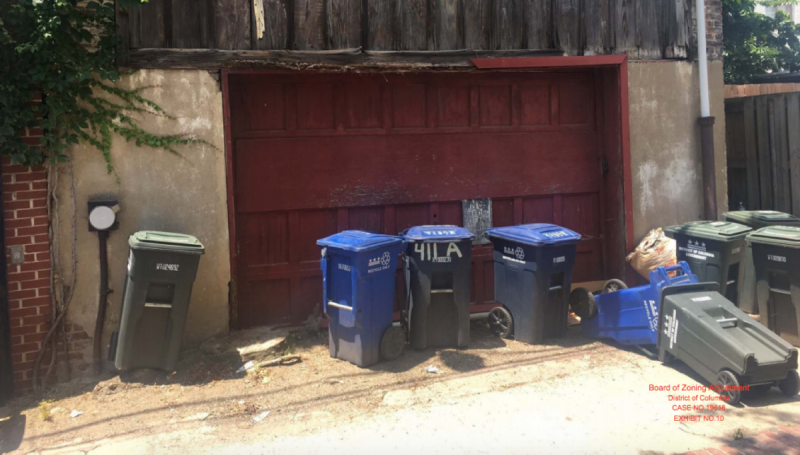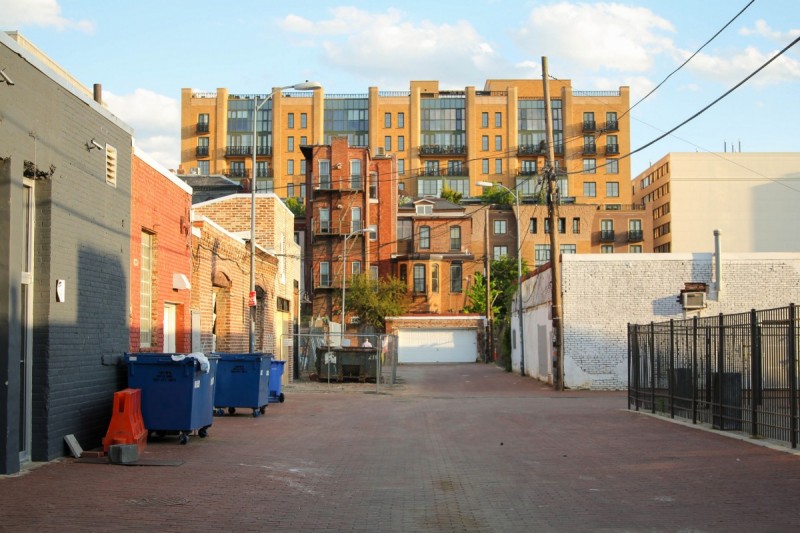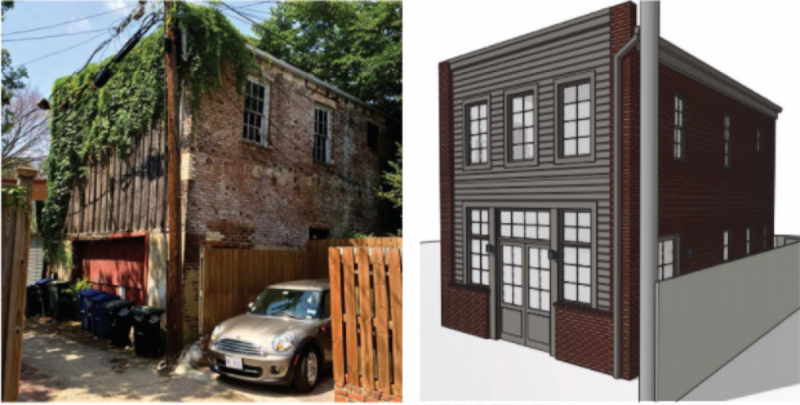Why are neighbors fighting to keep this decrepit alley building from becoming a house?

Image by Checa Architects used with permission.
The owner of a long-vacant alley building in Capitol Hill is trying to rehab their decaying property into a home, but neighbors are raising a variety of concerns to try to stop the process.
In the end, it looks suspiciously like some neighbors might be throwing delays into the process in order to force a sale to themselves.
Here is a map of the site.
An alley home in a city with a history of alley homes
The building under discussion is located in a narrow 10-foot-wide alley behind Fourth St NE. Part of what is unique about this case is that the plot of land is very small, not legally connected to any of the adjacent properties, and has no direct access to a public street.
The owner, who does not live DC, has done little with this building for years except use it for storage, and it is not in good shape. Neighbors seemed to have mostly ignored it and use the area to store their garbage cans.
Image by Board of Zoning adjustment.
Part of DC’s zoning update, which finally was enacted in September of last year, included reforms to what were previously very restrictive regulations on alley dwellings. DC has a unique history of people living in alleys. When the city supported a much higher population that it does today, alley dwellings were commonplace.
Then in 1934, Congress passed the Alley Dwelling Elimination Act, which functionally and legally cleared out the existing alley homes of DC and made it illegal for more than a decade for people to live in them. In anticipation of this act, most of the former residents of these homes (typically poor and black) had at that point already been forcibly displaced elsewhere.
Under the zoning code (which originated in 1958), alley homes were only legal in particular cases and typically only allowed in very wide alleys (at least 30 feet wide). This allowed for areas like Blagden alley and Naylor Court in Shaw to develop and include homes and other stores, but limited the use of buildings like this one near Fourth street.
Blagden Alley. Image by Joe Flood licensed under Creative Commons.
The new zoning code brought many changes to these regulations, including allowing alley dwellings by right in 24-foot-wide alleys, as well as in 15-foot-wide alleys as long as the building is within 300 feet of a public street and had direct access to the street. The building in question doesn’t fit these by-right rules, but the zoning code also now allows such cases if they go through a special zoning approval process that includes input from the local Advisory Neighborhood Commission (ANC) and other District agencies.
Neighbors threw the book at this one, but their arguments weren’t sticking
While the proposed designs for this building meet many of the new requirements for alley dwellings, the narrowness of the alley and the missing entrance onto a street require the owner to apply for a special exception, and at a recent ANC 6C zoning committee meeting neighbors came ready to fight. One woman came with a stack of printed documents six inches high, a poster board, and a laser pointer. It was going down.
Image by Checa Architects used with permission.
The proposed rehabilitation of the building is clear. It does not change the height, width, or footprint of the building at all. It merely turns the building into a habitable space with windows, plumbing, etc. There is also, notably, no garage or parking included in the plans, meaning that the new neighbor would rarely if ever drive down the alley.
Yet neighbors at the meeting raised concerns, and honestly some weren’t unreasonable. The narrowness of the alley will make construction very difficult for workers, as well as for neighbors that need to use the alley for disability access and to park their cars. A demand for a strictly followed construction management plan makes sense.
It also sucks to have lived in your home for years with your backyard open to this vacant building, only now to find out someone will live there with an easy view into your yard and home. Granted, we do all live in a city of 680,000+ people, and those of who live in apartments have learned to get over this rather quickly, or buy some shades. But hey, I get the frustration.
However, after that the arguments start to get fuzzy. The proposed rehab does not change the building at all in terms of its height, length or width, so the typical arguments you hear about the loss of air and light did not come up in the meeting.
Instead, neighbors kept coming back to the “safety of the future residents of the building.” One neighbor pointed out she couldn’t imagine living in a building that did not have an entrance AND an exit and she seriously questioned the legality and safety of such a design. (Again, for those of us who have lived in apartments with one door, we’ve made it through somehow.)
Others said that the alley was too narrow to allow for fire trucks and emergency vehicles — a moot point, as an ANC commissioner later pointed out, because they can use fire hoses.
Perhaps most strangely, many seemed to imply that the alley’s narrowness was going to lead to the new neighbor getting hit by a car as residents drove through to their parking spaces. It was a weird defense: a plea for the safety of their new neighbor… who they were all trying to block from living there… while also implicating themselves as being careless and possibly dangerous drivers.
Worrying about pedestrian and neighbor safety in the narrow alley during construction makes a lot of sense, but the logic of this other argument seemed flawed to me.
Finally, historic preservation was brought up, since the area is in an historic district. One committee member (who eventually voted against the proposal) asked for a more extensive review of the history of the home and its prior uses, arguing that alley buildings like that weren’t always used as homes.
Image by Board of Zoning adjustment.
The project moves forward, and ulterior motives are revealed?
Ultimately, after over an hour of discussion, the ANC committee voted in favor of the proposed plans 4-1 (with one abstention) with one strict condition: that a “satisfactory construction management agreement” be worked out beforehand.
As Mark Eckenwiler, Chair of the 6C committee (Planning, Zoning & Economic Development) pointed out later in an email, “In my opinion, the issues of neighbor privacy and construction impacts/disruption can likely be addressed through some modest concessions…that still fully allow this property to be restored and adapted to residential use. Put differently, the challenges here…are in my view details to be worked out, not reasons to deny the proposed use.”
Committee members seemed empathetic towards the protesting neighbors, but most didn’t see anything objectionable about the project. One made it clear that he thought the “highest and best use of this space was as a dwelling.”
Another asked the crowd, “You want this thing fixed up, but you don’t want it occupied? How is that going to work? You can’t just expect the owner to fix it up and do nothing with it. And even using the building as a studio or business would have the same effect in terms of traffic and use of the alley.”
Finally, one committee member asked the lawyer representing the case if there had been any talk of selling this isolated plot to one of the adjacent homeowners. Among a chorus of nodding heads in the room, the lawyer explained that multiple offers had been made during the process — all unsolicited by the owner, who just wants to build and rent out the home.
Up until this point I felt fairly sympathetic to many of the neighbors’ concerns, though I still disagreed with many. Once this last wrinkle was revealed, the whole thing felt much more suspicious: How much of this is really just an attempt to throw wrenches into the process until the owner gets frustrated and sells to one of these obstructing neighbors?
Maybe that is an unfair accusation, but overly protective land-use activism in more privileged neighborhoods during a serious housing shortage is usually suspect in my book.
As frustrated neighbors filed out, I couldn’t help but wonder — why so much energy spent fighting turning a decrepit storage space to a home, in a city starving for homes?
